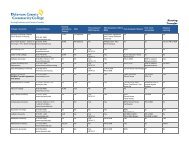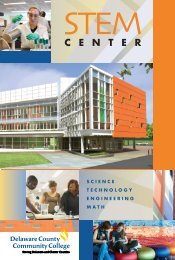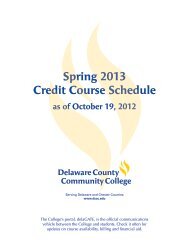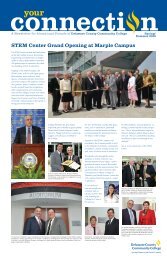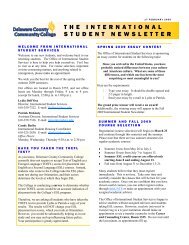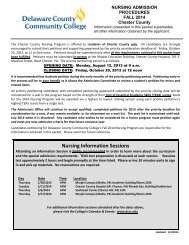2010 Catalog - Delaware County Community College
2010 Catalog - Delaware County Community College
2010 Catalog - Delaware County Community College
Create successful ePaper yourself
Turn your PDF publications into a flip-book with our unique Google optimized e-Paper software.
COURSE DESCRIPTIONS 165<br />
• Utilize the manufacturers' service manual for repair and<br />
adjustments for pioneer models SX-251R and PD-102<br />
• Demonstrate the ability to repair a stereo receiver<br />
Pioneer Model Sx-251R and a CD player Pioneer Model<br />
PD-102.<br />
Prereq. TEL 110<br />
4 Credits 3 Weekly Lecture Hours<br />
2 Weekly Laboratory Hours<br />
TEL 259 Nanofabrication<br />
Manufacturing Seminar<br />
This course gives an overview of typical Nanofabrication<br />
applications and provides an introduction to<br />
Nanofabrication Manufacturing Technology.<br />
Upon successful completion of this course, students<br />
should be able to:<br />
• Understand the typical application of Nanofabrication<br />
Manufacturing and obtain an overview of the industry.<br />
• In order to demonstrate this competency, the student<br />
should be able to:<br />
• Describe the various types of businesses in the<br />
nanotechnology field.<br />
• Explain the applications of the nano field.<br />
• Outline the career opportunities available in this field.<br />
Prereq. TEL 101<br />
1 Credit 2 Weekly Lecture Hours<br />
TEL 260 Materials, Safety, Health<br />
Issues and Equipment Special Studies<br />
This course provides an overview of basic nanofabrication<br />
processing equipment and material chemistry and<br />
handling procedures. The focus is on cleanroom protocol,<br />
safety, environmental and health issues in equipment<br />
operation and materials handling. Safety and health issues<br />
will be covered for the following topics: cleanroom operation;<br />
vacuum pump systems operation; furnace operation;<br />
chemical vapor deposition system operation; and vacuum<br />
deposition/etching system operation. Specific materials<br />
handling issues will include deionization water, solvents,<br />
cleaners, ion implantation sources, diffusion sources,<br />
photoresists, developers, metals, dielectrics, and toxic,<br />
flammable, corrosive, and high purity gases as well as<br />
packaging materials.<br />
Upon successful completion of this course, students<br />
should be able to:<br />
• Identify the basic nanofabrication processing equipment.<br />
• Describe the uses and applications of the basic<br />
nanofabrication processing equipment.<br />
• Identify safety hazards associated with nanofabrication.<br />
• Explain the fundamentals of vacuum technology<br />
including pumps, components, and metrology.<br />
• Identify materials used in nanofabrication manufacturing.<br />
• Operate material metrology equipment.<br />
• Associate the material handling issues with each<br />
identified nanofabrication material.<br />
• Explain basic chemical properties of materials.<br />
• Summarize basic cleanroom operation and protocol.<br />
• Demonstrate an understanding of basic cleanroom<br />
operation and protocol.<br />
Prereq. TEL 111, TEL 121, TEL 210, MAT 210, ENG 112<br />
3 Credits 2 Weekly Lecture Hours<br />
2 Weekly Laboratory Hours<br />
TEL 261<br />
Basic Nanofabrication Process<br />
This course provides an overview of basic processing<br />
steps in Nanofabrication (contact lithography, basic<br />
etching and deposition techniques). The majority of the<br />
course details a step-by-step description of the equipment<br />
and processes needed to fabricate devices and structures.<br />
Processing flow will be examined for structures such as<br />
microelectronic devices including diode and the MOS<br />
capacitor. Students receive an in depth introduction to<br />
basic lithography from wafer preparation to final inspection.<br />
Contamination issues in nanofabrication are discussed in<br />
detail. Students will learn the similarities and differences<br />
in both equipment and process flows for each configuration<br />
by undertaking "hands-on" processing.<br />
Upon successful completion of the course, students<br />
should be able to:<br />
• Perform basic lithography processes.<br />
• Operate contact lithography equipment.<br />
• Operate optical microscopes and imaging software.<br />
• Operate metrology equipment.<br />
• Explain electrical characterization equipment.<br />
• Describe the basic steps in p-n junction diode process flow.<br />
• Identify the equipment in p-n junction diode<br />
process flow.<br />
• Explain the complete p-n diode manufacturing<br />
process in a class 10 cleanroom.<br />
• Describe the basic steps in a MOS capacitor process flow.<br />
• Identify the equipment in a MOS capacitor process flow.<br />
• Compare the similarities and differences in equipment<br />
and process flow for the process flows listed above.<br />
Coreq. TEL 260<br />
3 Credits 2 Weekly Lecture Hours<br />
2 Weekly Laboratory Hours<br />
TEL 262<br />
Thin Film in Nanofabrication<br />
This course covers advanced thin film deposition and<br />
etching practices in nanofabrication. Advanced deposition<br />
techniques covered in the first part of the course include<br />
atmosphere, low-pressure and plasma enhanced chemical<br />
vapor deposition, sputtering, thermal and electron beam<br />
evaporation. The study of materials includes dielectrics,<br />
polysilicon and metals. The second part of the course<br />
focuses on advanced etching practices and techniques<br />
emphasizing reactive ion etching, high-density plasma<br />
systems, ion beam etching, and wet chemical etching.<br />
Students will receive hands-on experience in depositing<br />
and etching dielectric, semiconductor, and metallic materials<br />
using state-of-the-art tools and practicing many of the<br />
steps critical to nanofabrication of semiconductor devices<br />
including microelectronics, MEMs devices, display<br />
structures and structures used in the biotechnology fields.<br />
Upon successful completion of this course, students<br />
should be able to:<br />
• Explain all chemical vapor deposition (CVD) processes<br />
used in nanofabrication.<br />
• Explain the operation of CVD equipment.<br />
• Describe the uses of different CVD thin films in<br />
nanofabrication.<br />
• Explain all physical vapor deposition (PVD) processes<br />
used in nanofabrication.<br />
• Set up and operate equipment to perform PVD.<br />
• Describe the uses of different PVD thin films in<br />
nanofabrication.<br />
• Explain the processes in wet chemical etching techniques.<br />
• Set up and operate equipment to perform wet<br />
chemical etching.<br />
• Describe the uses of wet chemical etching techniques.<br />
• Explain the processes in plasma etching techniques<br />
used in nanofabrication.<br />
• Set up and operate equipment to perform plasma etching.<br />
• Describe the uses of plasma etching techniques.<br />
• Operate a scanning electron microscope for<br />
materials characterization.<br />
Prereq. TEL 261<br />
3 Credits 2 Weekly Lecture Hours<br />
2 Weekly Laboratory Hours<br />
TEL 263<br />
Lithography for<br />
Nanofabrication<br />
This course covers all aspects of advanced lithography<br />
from design and mask fabrication to pattern transfer and<br />
inspection. The course is divided into three major sections.<br />
The first section describes the advanced lithographic<br />
process from substrate preparation to exposure. Most of<br />
the emphasis is on understanding the nature and<br />
behavior of photoresist materials. The second section<br />
examines systems and techniques that define patterns.<br />
This section will introduce specialized optical masks and<br />
reticles, aligners, steppers and scanners. In addition,<br />
critical dimension (CD) control and profile control of<br />
photoresist will be investigated. The last section will<br />
discuss advanced optical lithographic techniques such as<br />
phase shifting masks and illumination schemes as well<br />
as e-beam, e-ray, EUV, and ion beam lithography. A<br />
section about engineering dielectrics is also discussed.<br />
Upon successful completion of this course, students<br />
should be able to:<br />
• Explain the process steps necessary to produce a<br />
photolithographic pattern in positive, negative and<br />
chemically amplified resists.<br />
• Describe the nature and behavior of photoactive<br />
materials such as BCB.<br />
• Describe all lithographic techniques in nanofabrication.<br />
• Explain mask layout and fabrication for photolithography.<br />
• Describe and perform alignment and registration<br />
in photolithography.<br />
• Identify the equipment used in photolithography.<br />
• Set up and operate equipment used in photolithography.<br />
Modify profiles in photoresist for liftoff applications.<br />
Coreq. TEL 262<br />
3 Credits 3 Weekly Lecture Hours<br />
TEL 264 Materials Modification<br />
in Nanofabrication<br />
This course will cover in detail the processing steps<br />
used in modifying material properties in nanofabrication.<br />
An intensive study of metals used in nanotechnology aids<br />
the student in understanding the various methods of<br />
metalization such as CVD, evaporation, and sputtering.<br />
Metal applications for interconnect technologies will be<br />
examined. Aluminum, refactory metals and copper<br />
deposition techniques and characterization will be<br />
discussed in detail along with topics such as diffusion<br />
barriers, contact resistance, electromigration, corrosion,<br />
stress effects, and adhesion. Other modification technologies<br />
such as ion implementation, diffusion and<br />
surface preparation and treatment are integrated as well.<br />
An intensive study of dielectric properties and materials<br />
including dielectric constant engineering, mechanical,<br />
optical, and electrical characteristics, poly, BSG, PSG,<br />
SOG, and BPSG gives the student further insight into<br />
advanced device fabrication. Material properties and<br />
basic device structures will be discussed for the<br />
optoelectronic market.<br />
Upon successful completion of this course, students<br />
should be able to:<br />
• Contrast thermally grown oxides with spin<br />
on dielectrics.<br />
• Identify the processing equipment for slicing, etching<br />
and polishing.<br />
• Describe the procedures for slicing, etching, polishing,<br />
and epitaxial growth.<br />
• Perform advanced fabrication techniques.<br />
• Determine the processing parameters of<br />
dielectric materials.<br />
• Explain the concept of engineering dielectric constants<br />
for different nanofabrication applications.<br />
• Explain metalization techniques and processing<br />
equipment.<br />
• Select appropriate materials to match the design<br />
needs of nanofabricated devices.<br />
• Describe the process of direct bandgap<br />
photonic emission.<br />
• Examine common materials and properties for the<br />
optoelectronic market.<br />
• Describe the need for optoelectronic devices.<br />
Prereq. TEL 263 Coreq. TEL 265<br />
3 Credits 2 Weekly Lecture Hours<br />
2 Weekly Laboratory Hours




